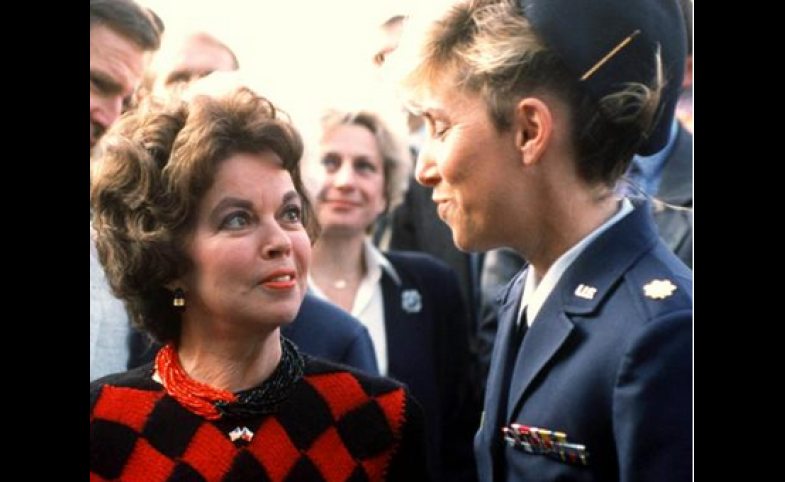Shirley Temple Black, an American cultural icon of the Great Depression Era, and U.S. Ambassador to both Ghana (1974-76) and Czechoslovakia (1989-92), passed away on Monday, February 10th. CPD reached out to a few public...
KEEP READINGThe CPD Blog is intended to stimulate dialog among scholars and practitioners from around the world in the public diplomacy sphere. The opinions represented here are the authors' own and do not necessarily reflect CPD's views. For blogger guidelines, click here.

Good Ship USA - a remembrance of Ambassador Shirley Temple Black
I’m a Shirley Temple fan. Not a big fan of her movies; they seemed more suited for my sister. I’m a fan of her diplomacy in Czechoslovakia. I was a Newsweek reporter living in Prague between the 1989 “Velvet Revolution” and 1991 when I saw up close how Ambassador Shirley Temple Black worked it. That’s how I became a fan. (Disclosure: I like ambassadors, my wife was U.S. ambassador to Hungary 2010-13.)
America has had many notable diplomats dealing with Czechoslovakia, or the more modern Czech Republic, a country split from Slovakia in 1993 following a “Velvet Divorce.”
But Shirley Temple Black’s watch came at a seminal moment in modern Czechoslovak history and she was, perhaps unexpectedly, the right person at the right time.
Her personal and informal style worked well with the new government, made up of formerly imprisoned, hard laboring and human rights Charter 77-signing artists, musicians, actors and a playwright president named Vaclav Havel. Many of those new Czechoslovak political leaders admired their American colleague, President Ronald Reagan, an actor-politician like themselves who expressed in the clearest terms – and to the whole world – their deepest desire for freedom.
In Shirley Temple Black, the Czechoslovaks had a new diplomat-artist colleague who shared Reagan’s sentiments and temperament.
During early street protests in Prague in 1989, she spoke out for more democratic freedom and in thinly veiled language against the Husak government to which she was credentialed. And as the Berlin Wall fell and the distinct scent of revolution filled the Eastern European air, people filled central Wenceslas Square and jangled their keys in protest. Shaking those keys meant that they wanted to lock out the communists and open the door to democracy. Suddenly she became the U.S. ambassador to a reborn and dramatically transitioning state.
Thankfully, she knew something about drama. And timing.
Timing brought her to Czechoslovakia for the first time in 1968, in the midst of the Prague Spring and the crackdown on reformers. And a combination of actor’s good luck and timing brought her back for the Prague Spring’s reversal in 1989.
The most visible part of diplomacy consists of public meetings or events, speeches given, parties thrown. But most of the work takes place away from the public eye. Public and private diplomacy require the ability to perform for and understand an audience, and she was skilled at both.
When it came to the new Czechoslovak leadership, she knew these people and what motivated them, understood their anti-establishment tendencies, and gained their respect not merely because of her recognized early film work, but also because her ability to take the stage and perform whatever diplomatic duties were necessary.
Because of her GOP star power and her husband Charlie’s own network she was able to attract a never-ending stream of American officials and business people to Prague. She enticed them to come and witness the unfolding story of the Velvet Revolution.
Peaceful democratic change was as strong a draw as the incomparable fairytale beauty of the Prague castle, and the visits got Czechoslovakia added attention in the halls of Congress.
The first six months after the revolution felt like a nationwide party. And the embassy grounds were no exception. Journalists often were invited to events at the ambassador’s residence and whenever congressional delegations came through town, she opened up the Petschek Palace doors, located on recently renamed Ronald Reagan Street.
At my first reception, I asked a white-jacketed staff member in Czech (and loosely translated into English) “Is Shirley Temple available?” He looked over toward the ambassador and nodded. I then said, “Please procure me Shirley Temple” at which point the bartender nearly dropped the glass he was holding. He had never heard of the drink.
At these receptions, every American or Czechoslovak guest eventually made it to the drawing room, where the ambassador’s Oscar statuette sat on a bookshelf. I often sat and watched as one person after another grabbed the Oscar, felt its heft and held it high, sometimes giving a very short acceptance speech. And the ambassador often would take a photo next to the new Oscar “winner.” This was the type of cultural diplomacy that money can’t buy.
Guests sometimes wanted to linger, but the ambassador usually made it clear when the party was over. She would stand in the foyer, kick off her sky-high heels, light up a cigarette and open up the garden door to let in her dog, a boxer named Gorby, named after Soviet leader, Mikhail Gorbachev. Gorby’s latent herding instinct kicked in and moved guests slowly toward the exit.
Now that she has headed off-stage, it’s time to raise a glass of grenadine and 7Up and bid a fan’s fond farewell.
This article originally appeared in The Sacramento Bee. Read the original here.
Visit CPD's Online Library
Explore CPD's vast online database featuring the latest books, articles, speeches and information on international organizations dedicated to public diplomacy.
POPULAR ARTICLES
-
January 2
-
December 15
-
December 17
-
November 25
-
December 17
Join the Conversation
Interested in contributing to the CPD Blog? We welcome your posts. Read our guidelines and find out how you can submit blogs and photo essays >.













